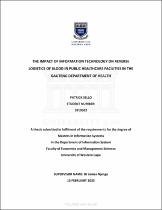| dc.description.abstract | The South African National Blood Service (SANBS) estimates that over 900,000 blood units are collected yearly from 1% of the population of South Africa (SA) actively donating blood, but 40% of the donated blood is estimated to be wasted across public healthcare facilities. As a result, surgical procedures have been cancelled or postponed, putting patients' lives at risk. This waste has been attributed to poor logistics of blood products between South African National Blood Services (SANBS) and hospitals, lack of technology to facilitate the logistics of blood products, and poor infrastructure to support the return of unused blood within the regulated period. Furthermore, blood products such as red blood cells (RBC) are prone to high wastage due to patient passing before blood transfusion, patients discharged with blood already ordered and delivered, patients refusing blood transfusion due to religious affiliation, change in Hb levels before transfusion, and poor coordination between health workers that results in limited communication during delivery of medical services. This study maps the reverse logistics (RL) process for blood products in public healthcare facilities (PHF) to identify barriers to implementing the RL process in PHF and the key factors driving the waste of blood products and recommends implementing a technological solution and reverse logistics processes for the logistics of blood products to reduce blood waste. Transporting blood in brown bags and mapping current logistical processes for blood products in on-site and remote blood bank hospitals reveal gaps that prevent returning unused blood products to blood banks. This study focuses on medical professionals, where various blood products (red blood cells (RBC), fresh frozen plasma, and platelets) were identified for the research. A quantitative applied research approach
was chosen as the preferred methodology, and a stratified random sampling method was used to select participants, stratify the population, and collect data from each subgroup. The key findings point to a 51% waste of RBC units in the four selected hospitals, attributed to poor infrastructure to support the return of unused blood products, unstandardised processes across the similar level of care hospitals, poor logistics processes for blood products, and inefficient communication between doctors and nurses responsible for delivering medical services. The study identifies inaccurate information because of manual processes and poor monitoring of policies and guidelines as barriers to the reverse logistics of blood products. Technology and logistics methods are suggested as mitigating effects to address the above findings and reduce blood waste during medical service delivery. The findings add to the body of academic knowledge, technology, and logistics as factors to improve the delivery of healthcare services in the public health context. They also support the recommendation that PHF uses technology to automate business processes while integrating logistics methods and models for delivering and handling blood products. | en_US |

